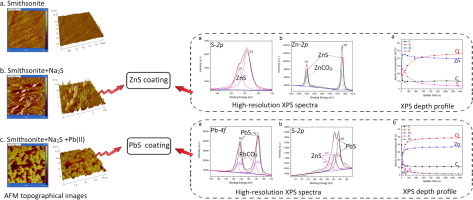当前位置:
X-MOL 学术
›
Appl. Surf. Sci.
›
论文详情
Our official English website, www.x-mol.net, welcomes your
feedback! (Note: you will need to create a separate account there.)
The role of S(II) and Pb(II) in xanthate flotation of smithsonite: Surface properties and mechanism
Applied Surface Science ( IF 6.3 ) Pub Date : 2018-06-01 , DOI: 10.1016/j.apsusc.2018.02.132
Kai Jia , Qiming Feng , Guofan Zhang , Wanying Ji , Wukai Zhang , Bingqian Yang
Applied Surface Science ( IF 6.3 ) Pub Date : 2018-06-01 , DOI: 10.1016/j.apsusc.2018.02.132
Kai Jia , Qiming Feng , Guofan Zhang , Wanying Ji , Wukai Zhang , Bingqian Yang

|
Abstract Smithsonite is a readily dissolvable carbonate mineral that is naturally hydrophilic, making recovery of this ore by flotation difficult. The flotation results showed that conditioning with only sodium sulfide (Na2S) did not successfully allow the smithsonite samples to float, whereas treatment with a combination of S(II), Pb(II) and xanthate (with Na2S as the sulfurizing reagent, lead ions (Pb(II)) as the activator, and xanthate as the collector) improved the flotation of smithsonite, achieving a mass recovery of 95.8%. A combination of analytical techniques, including X-ray diffraction (XRD), atomic force microscopy (AFM) and X-ray photoelectron spectroscopy (XPS), in conjunction with depth profiling, was used to investigate the chemical nature of the sulfur and lead species on the smithsonite surface. For S(II)-conditioned smithsonite, a layer of ZnS formed on the smithsonite (ZnCO3) substrates; this newly formed ZnS coating was amorphous or poorly crystallized. For smithsonite samples conditioned with S(II) and Pb(II), the microstructures and the phase constituents, obtained by AFM and XRD analyses, confirmed the formation of the PbS species with a cubic galena structure on the surface. XPS depth profiling showed that the PbS layer was 18-nm thick, which corresponds to 30 PbS molecular layers. This study presents direct evidence that the coating of the activation product, PbS, on the smithsonite surface was similar to a relatively thick galena layer, which led to successful flotation.
中文翻译:

S(II)和Pb(II)在菱锌矿黄药浮选中的作用:表面性质和机理
摘要 Smithsonite 是一种易于溶解的碳酸盐矿物,天然亲水,因此很难通过浮选回收这种矿石。浮选结果表明,仅用硫化钠 (Na2S) 调节不能成功地使菱锌矿样品漂浮,而用 S(II)、Pb(II) 和黄药(以 Na2S 作为硫化剂,铅离子)的组合处理(Pb(II)) 作为活化剂,黄药作为捕收剂) 改善了菱锌矿的浮选,达到了 95.8% 的质量回收率。X 射线衍射 (XRD)、原子力显微镜 (AFM) 和 X 射线光电子能谱 (XPS) 等分析技术与深度剖析相结合,用于研究硫和铅物种的化学性质在菱锌矿表面。对于 S(II) 条件菱锌矿,在菱锌矿 (ZnCO3) 基材上形成一层 ZnS;这种新形成的 ZnS 涂层是无定形的或结晶不良的。对于用 S(II) 和 Pb(II) 处理的菱锌矿样品,通过 AFM 和 XRD 分析获得的微观结构和相成分证实了表面具有立方方铅矿结构的 PbS 物种的形成。XPS 深度分析显示 PbS 层厚 18 nm,相当于 30 个 PbS 分子层。这项研究提供了直接证据,表明菱锌矿表面上的活化产物 PbS 涂层类似于相对较厚的方铅矿层,从而导致成功浮选。通过 AFM 和 XRD 分析获得的微观结构和相成分证实了在表面形成立方方铅矿结构的 PbS 物种。XPS 深度分析显示 PbS 层厚 18 nm,相当于 30 个 PbS 分子层。这项研究提供了直接证据,表明菱锌矿表面上的活化产物 PbS 涂层类似于相对较厚的方铅矿层,从而导致成功浮选。通过 AFM 和 XRD 分析获得的微观结构和相成分证实了在表面形成立方方铅矿结构的 PbS 物种。XPS 深度分析显示 PbS 层厚 18 nm,相当于 30 个 PbS 分子层。这项研究提供了直接证据,表明菱锌矿表面上的活化产物 PbS 涂层类似于相对较厚的方铅矿层,从而导致成功浮选。
更新日期:2018-06-01
中文翻译:

S(II)和Pb(II)在菱锌矿黄药浮选中的作用:表面性质和机理
摘要 Smithsonite 是一种易于溶解的碳酸盐矿物,天然亲水,因此很难通过浮选回收这种矿石。浮选结果表明,仅用硫化钠 (Na2S) 调节不能成功地使菱锌矿样品漂浮,而用 S(II)、Pb(II) 和黄药(以 Na2S 作为硫化剂,铅离子)的组合处理(Pb(II)) 作为活化剂,黄药作为捕收剂) 改善了菱锌矿的浮选,达到了 95.8% 的质量回收率。X 射线衍射 (XRD)、原子力显微镜 (AFM) 和 X 射线光电子能谱 (XPS) 等分析技术与深度剖析相结合,用于研究硫和铅物种的化学性质在菱锌矿表面。对于 S(II) 条件菱锌矿,在菱锌矿 (ZnCO3) 基材上形成一层 ZnS;这种新形成的 ZnS 涂层是无定形的或结晶不良的。对于用 S(II) 和 Pb(II) 处理的菱锌矿样品,通过 AFM 和 XRD 分析获得的微观结构和相成分证实了表面具有立方方铅矿结构的 PbS 物种的形成。XPS 深度分析显示 PbS 层厚 18 nm,相当于 30 个 PbS 分子层。这项研究提供了直接证据,表明菱锌矿表面上的活化产物 PbS 涂层类似于相对较厚的方铅矿层,从而导致成功浮选。通过 AFM 和 XRD 分析获得的微观结构和相成分证实了在表面形成立方方铅矿结构的 PbS 物种。XPS 深度分析显示 PbS 层厚 18 nm,相当于 30 个 PbS 分子层。这项研究提供了直接证据,表明菱锌矿表面上的活化产物 PbS 涂层类似于相对较厚的方铅矿层,从而导致成功浮选。通过 AFM 和 XRD 分析获得的微观结构和相成分证实了在表面形成立方方铅矿结构的 PbS 物种。XPS 深度分析显示 PbS 层厚 18 nm,相当于 30 个 PbS 分子层。这项研究提供了直接证据,表明菱锌矿表面上的活化产物 PbS 涂层类似于相对较厚的方铅矿层,从而导致成功浮选。































 京公网安备 11010802027423号
京公网安备 11010802027423号